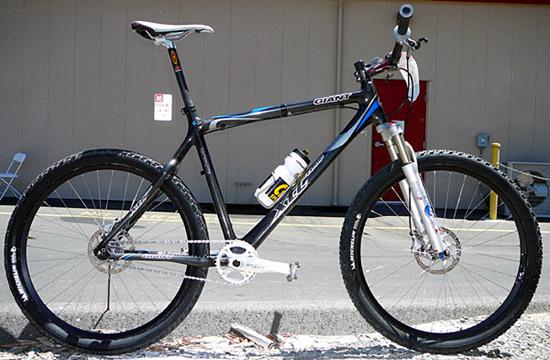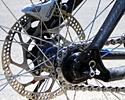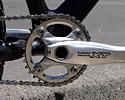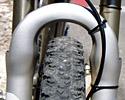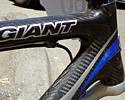
Recently on Cyclingnews.com |
Pro bikes, October 5, 2006
Carl Decker's Giant XTC Composite 1 Carbon Singlespeed
Decker picks singlespeed for some non-singlespeed racesBy Sue George and Steve Medcroft The short track course at the mid-July 2006 NORBA USA National Championship in Sonoma, California - a mostly paved route with several hundred meters of climbing per lap- got racers thinking about their equipment. Trek/VW's Ross Schnell ran a rigid front fork, a 700c front wheel and a standard 26-inch rear wheel. Subaru/Gary Fisher's Jeremy Horgan-Kobelski went with carbon Bontrager cyclo-cross wheels and tires. However one of the most unusual choices of equipment to bring to such a high-caliber event was made by Team Giant's Carl Decker; he brought his singlespeed, on which he won the singlespeed national championships the day before, to the start line. "I ran faster laps in the singlespeed cross-country than I did on my regular bike on Friday (in the open cross-country race)," he said at the time. "I did a lap of the course on both bikes and brought what I thought would be fastest." Since bike sponsor Giant no longer offers a singlespeed due to low sales in the niche category, Decker took a unique approach to acquiring his one-geared racer; he modified his 2005 team-issued hardtail. Decker says his conversion of the geared bike, which featured essentially the same frame as his 2006 XT-C, is simple; but takes time and patience. For the first step, Decker said, "I cut the (derailleur) hangers off. My magic system for getting the right chain tension involves starting with a handful of [used] chains with different stretches and a bunch of chainrings. To get that perfect tension without any of those little do-hickeys and with these [non-horizontal] dropouts, you just have to take the hour or two hours to find the perfect combination. I've done it a bunch of times." One big advantage to Decker's conversion is that by using the same frame for his singlespeed and his hardtail, all the measurements are the same for both bikes. That makes setting up the singlespeed and later switching between both bikes easier for him. Decker runs a standard cassette-style hub with a special spacer to put the cog in place. He could not recall details about the spacer - saying only that his mechanic bought it out of the Quality Bicycle Products catalog - but he described his gearing of choice. "I always run the same gearing, 32 x 15 or 34 x 16, just a little over a 2:1 ratio. Which is perfect for most races." Although he hates spinning out on his regular bike and would rather coast instead, Decker said, "On a singlespeed, I think I feel better when I'm at a higher cadence." Emphasizing the importance of weight, Decker said, "I aim to make everything as light and fast as possible on a singlespeed–even more so than on a regular race bike. Just because you only have that one gear and you have to get up all the quality climbs so you have to be able to accelerate all the time, over and over again all day." The bottom line is "less is more; you still need a suspension fork to be able to hang on the descents and decent tires so you don't flat." Decker handles the suspension with a Fox F 80X 80mm fork with Terralogic terrain sensitive inertia valve, so he does not have to activate a manual lock-out; the fork locks out automatically until it is needed. He also runs tubeless tires on his singlespeed, but a different model front and rear (for the Sonoma short-track race, for example, he chose Michelin XC Dry and Hard Terrain for the front and rear respectively). The rest of Decker's singlespeed is equipped with fairly standard components; a mix of XTR, XT, and Deore LX for hubs, cranks, and brakes. Easton carbon bars, stem, and seatpost help keep the bike's overall weight low. Decker says he started riding singlespeed "six or seven years ago in Oregon. Just at local races. Adam [Craig] and I like riding singlespeed. The trails around Bend [Oregon] are really flat. You can even ride road bikes on a lot of the trails. Singlespeeding just makes it more interesting." Expect to see more of Decker on his singlespeed at races. If his sixth place short track finish, only fifteen seconds off the winner, is any indication, there will be no reason for him to add more gears any time soon. PhotosFor a thumbnail gallery of these images, click here Images by Steve Medcroft/Cyclingnews.com
|
|||||||

